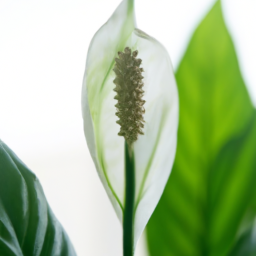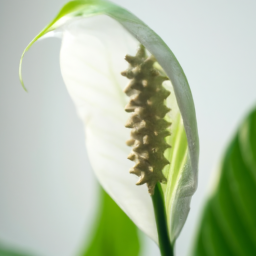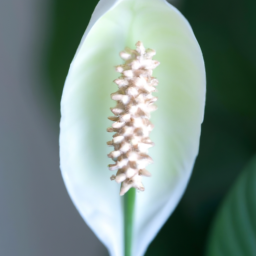
Are you looking to bring some greenery into your home? Indoor plants like Peace Lily are a great option to add a touch of nature to your living space. Not only are they beautiful to look at, but they also offer a range of benefits for your health and well-being. In this blog post, we will explore the beauty and benefits of indoor plants like Peace Lily, and provide tips on how to care for these lovely additions to your home. So, grab a cup of tea and join us as we delve into the world of indoor plants!
Benefits of Having Peace Lily as an Indoor Plant
Improved Air Quality
One of the main benefits of having a Peace Lily as an indoor plant is its ability to improve air quality. Peace Lilies are known for their air-purifying properties, as they can help remove harmful toxins such as formaldehyde, benzene, and trichloroethylene from the air. This can lead to a healthier indoor environment, especially for those who suffer from allergies or respiratory issues.
In addition, Peace Lilies can also help increase humidity levels in a room, which can be beneficial for those living in dry climates or during the winter months when indoor air tends to be drier. This can help prevent dry skin, irritated eyes, and respiratory problems.
Overall, having a Peace Lily in your home can help create a cleaner and healthier living space for you and your family.
Easy to Care For
Another benefit of having a Peace Lily as an indoor plant is that they are relatively easy to care for. Peace Lilies are low-maintenance plants that thrive in indirect sunlight and moderate temperatures. They prefer to be kept in well-draining soil and watered regularly, but not overwatered.
Peace Lilies are also known for their ability to adapt to various light conditions, making them a great option for indoor spaces that may not receive a lot of natural sunlight. They can even tolerate low-light conditions, although they may not flower as frequently in these conditions.
Overall, Peace Lilies are a great choice for those who are new to indoor gardening or who may not have a green thumb, as they are forgiving plants that can thrive in a variety of environments.
Beautiful Aesthetic
Aside from their air-purifying properties and ease of care, Peace Lilies are also valued for their beautiful aesthetic. With their dark green leaves and elegant white flowers, Peace Lilies can add a touch of elegance and tranquility to any indoor space.
Peace Lilies are versatile plants that can be placed in a variety of containers and arrangements, making them a great choice for adding a pop of color and texture to your home decor. Whether placed on a tabletop, shelf, or floor, Peace Lilies can brighten up any room and create a calming atmosphere.
Overall, Peace Lilies are not only beneficial for your health and well-being, but they can also enhance the visual appeal of your indoor space and bring a sense of peace and serenity to your home.

Tips for Caring for Peace Lily Plants Indoors
Peace lilies are popular indoor plants known for their lush green foliage and elegant white flowers. They are relatively easy to care for, making them a great choice for both beginner and experienced plant enthusiasts. In this guide, we will provide you with some tips on how to care for your peace lily plants indoors to ensure they thrive and bloom beautifully.
Lighting
One of the most important factors to consider when caring for peace lilies indoors is lighting. Peace lilies prefer bright, indirect light, so it is best to place them near a window where they can receive filtered sunlight. Avoid exposing your peace lily to direct sunlight, as this can scorch their leaves. If you notice that your peace lily’s leaves are turning yellow or brown, it may be a sign that they are receiving too much light. On the other hand, if the leaves are drooping or the plant is not blooming, it may indicate that it is not getting enough light.
During the winter months when natural light is limited, you can supplement your peace lily’s light requirements with artificial grow lights. Place the grow lights a few feet above the plant and keep them on for 12-14 hours a day to mimic natural sunlight. This will help promote healthy growth and flowering in your peace lily.
It is important to rotate your peace lily occasionally to ensure even growth on all sides of the plant. This will prevent the plant from leaning towards the light source and encourage a more symmetrical appearance.
Watering
Proper watering is essential for the health of your peace lily plants. Peace lilies prefer consistently moist soil, but they do not like to sit in waterlogged conditions. Allow the top inch of soil to dry out slightly between waterings, and then water thoroughly until water drains out of the bottom of the pot. Empty the saucer underneath the pot to prevent the plant from sitting in standing water, which can lead to root rot.
It is important to use room temperature water when watering your peace lily, as cold water can shock the plant’s roots. You can also use filtered or distilled water to prevent mineral buildup in the soil, which can harm the plant over time. Avoid overwatering your peace lily, as this can lead to root rot and other issues. If you notice that the leaves are turning yellow or drooping, it may be a sign that the plant is being overwatered.
During the winter months when the plant is not actively growing, you can reduce the frequency of watering to prevent the soil from becoming waterlogged. Monitor the soil moisture levels regularly and adjust your watering schedule accordingly to meet the plant’s needs.
Humidity
Peace lilies thrive in high humidity environments, so it is important to provide them with adequate moisture in the air. You can increase humidity levels around your peace lily by placing a humidifier nearby or by grouping plants together to create a microclimate. Another option is to mist the plant’s leaves regularly with a spray bottle filled with room temperature water. This will help prevent the leaves from drying out and promote healthy growth.
If you notice that the tips of the leaves are turning brown or the plant is not flowering, it may be a sign that the air around the plant is too dry. Increasing humidity levels can help alleviate these issues and improve the overall health of your peace lily. You can also place a tray filled with water and pebbles near the plant to create a humid environment, or use a humidity tray underneath the pot to provide additional moisture.
By following these tips for caring for your peace lily plants indoors, you can ensure that they thrive and bloom beautifully year-round. With proper lighting, watering, and humidity levels, your peace lily will reward you with lush green foliage and elegant white flowers that brighten up any indoor space.

Best Indoor Plants Similar to Peace Lily for Low-Light Environments
Introduction
When it comes to indoor plants, the Peace Lily is a popular choice for its beautiful white flowers and air-purifying qualities. However, if you are looking for other options that are similar to the Peace Lily and can thrive in low-light environments, there are several alternatives to consider. In this article, we will explore three of the best indoor plants that are similar to the Peace Lily and are perfect for low-light conditions.
Snake Plant
The Snake Plant, also known as Mother-in-Law’s Tongue, is a hardy and low-maintenance plant that is perfect for beginners. It thrives in low-light environments and can go for weeks without water, making it an ideal choice for those who may not have a green thumb. The Snake Plant has long, upright leaves that are variegated with shades of green and yellow, adding a pop of color to any room. In addition to its aesthetic appeal, the Snake Plant is also known for its air-purifying qualities, making it a great choice for improving indoor air quality.
Another benefit of the Snake Plant is its ability to thrive in a variety of conditions, including low light and dry air. This makes it a versatile plant that can adapt to different environments, making it perfect for offices, bedrooms, or any room with minimal sunlight. To care for a Snake Plant, simply water it sparingly and place it in indirect sunlight. Avoid overwatering, as this can lead to root rot. With minimal care, the Snake Plant will thrive and add a touch of greenery to your home.
In conclusion, the Snake Plant is an excellent alternative to the Peace Lily for low-light environments. Its hardy nature, air-purifying qualities, and aesthetic appeal make it a great choice for those looking for a low-maintenance indoor plant.
ZZ Plant
The ZZ Plant, also known as Zamioculcas Zamiifolia, is another great indoor plant that is similar to the Peace Lily and thrives in low-light conditions. This plant has glossy, dark green leaves that add a touch of elegance to any room. The ZZ Plant is known for its ability to survive in low light and drought conditions, making it a perfect choice for those who may forget to water their plants regularly. Additionally, the ZZ Plant is a slow grower, so you won’t have to worry about it outgrowing its space quickly.
One of the key benefits of the ZZ Plant is its air-purifying qualities. Like the Peace Lily, the ZZ Plant can help improve indoor air quality by removing toxins such as formaldehyde and benzene from the air. This makes it a great choice for those looking to create a healthier indoor environment. To care for a ZZ Plant, water it sparingly and place it in indirect sunlight. Avoid overwatering, as this can lead to root rot. With minimal care, the ZZ Plant will thrive and bring a touch of greenery to your home.
In conclusion, the ZZ Plant is a wonderful alternative to the Peace Lily for low-light environments. Its glossy leaves, air-purifying qualities, and low-maintenance nature make it a great choice for those looking for an elegant indoor plant.
Cast Iron Plant
The Cast Iron Plant, also known as Aspidistra Elatior, is a tough and resilient indoor plant that is perfect for low-light environments. This plant has dark green, leathery leaves that can withstand neglect and low light conditions, making it an ideal choice for those who may not have the time to care for their plants regularly. The Cast Iron Plant is known for its ability to survive in a variety of conditions, including low light, dry air, and fluctuating temperatures.
One of the key benefits of the Cast Iron Plant is its low-maintenance nature. This plant requires minimal care and can thrive in conditions where other plants may struggle. To care for a Cast Iron Plant, water it sparingly and place it in indirect sunlight. Avoid overwatering, as this can lead to root rot. With minimal care, the Cast Iron Plant will thrive and bring a touch of greenery to your home.
In conclusion, the Cast Iron Plant is a fantastic alternative to the Peace Lily for low-light environments. Its tough nature, low-maintenance qualities, and resilience make it a great choice for those looking for a plant that can withstand neglect and thrive in low-light conditions.
Highlights of this article
Are you looking to add some greenery to your home but not sure where to start? Consider bringing in a peace lily! These beautiful indoor plants are not only easy to care for but also have a number of benefits for your home and health. Peace lilies are known for their striking white flowers and glossy green leaves, making them a lovely addition to any room.
One of the best things about peace lilies is that they are great air purifiers, helping to remove toxins from the air and improve indoor air quality. They are also low maintenance plants, requiring only moderate light and water to thrive. So if you’re looking for a plant that is both beautiful and beneficial, consider adding a peace lily to your indoor garden.
FAQ Compilation:
Q1: What are some indoor plants similar to Peace Lily?
A1: Some indoor plants similar to Peace Lily include Spider Plant, Snake Plant, and Philodendron. These plants are also low-maintenance and great for indoor spaces.
Q2: How often should I water indoor plants like Peace Lily?
A2: Indoor plants like Peace Lily should be watered when the top inch of soil feels dry to the touch. Typically, this means watering about once a week, but be sure to adjust based on your specific plant’s needs.
Q3: Do indoor plants like Peace Lily need sunlight?
A3: Yes, indoor plants like Peace Lily do need some indirect sunlight to thrive. Place them near a window where they can get filtered sunlight throughout the day.
Q4: Can indoor plants like Peace Lily improve air quality?
A4: Yes, indoor plants like Peace Lily are known for their air-purifying qualities. They can help remove toxins from the air and create a healthier indoor environment.
Q5: How can I prevent pests from infesting indoor plants like Peace Lily?
A5: To prevent pests from infesting indoor plants like Peace Lily, regularly check the leaves and stems for any signs of pests. You can also wipe down the leaves with a damp cloth and keep the plant in a well-ventilated area to discourage pests.
Dr. Olivia Green is a botanist with over two decades of experience in indoor plant cultivation. She holds a Ph.D. in Plant Biology and has dedicated her career to researching plant behavior in controlled environments. Dr. Green is passionate about helping plant enthusiasts master the art of indoor gardening through her extensive knowledge and practical insights.


